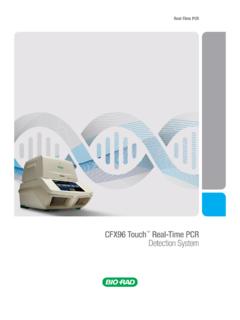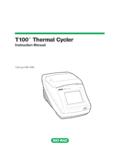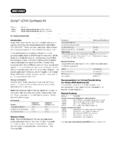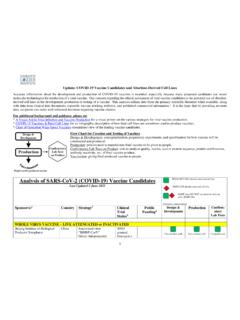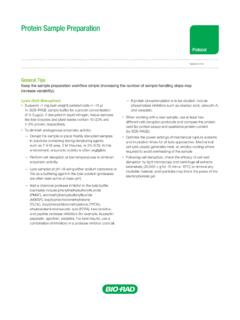Transcription of A Guide to Polyacrylamide Gel Electrophoresis and Detection
1 Electrophoresis A Guide to Polyacrylamide Gel Electrophoresis and DetectionBEGINTABLE OF CONTENTSPart I: Theory and Product Selection 5 Chapter 1 Overview 5 How protein Electrophoresis Works 6 General Considerations and Workflow 6 Chapter 2 protein Electrophoresis Methods and Instrumentation 9 protein Electrophoresis Methods 10 Polyacrylamide Gel Electrophoresis (PAGE) 10 Discontinuous Native PAGE 10 SDS-PAGE 11 Other Types of PAGE 12 Blue Native PAGE (BN-PAGE) 12 Zymogram PAGE 12 Isoelectric Focusing (IEF) 12 2-D Electrophoresis 13 Electrophoresis Cells and Power Supplies 13 Electrophoresis Cells 13 Power Supplies for PAGE Applications 15 Chapter 3 Sample Preparation for Electrophoresis 17 General Considerations 19 Cell Disruption 19 protein Solubilization 20 Detergents 20 Reducing Agents 20 Chaotropic Agents 21 Buffers and Salts 21 Common Solutions for protein Solubilization 21 Removal of Interfering Substances 21 Immunoprecipitation 22 Sample Quantitation ( protein Assays)
2 22 protein Assays 23 Chapter 4 Reagent Selection and Preparation 25 General Considerations 26 protein Standards 26 Recombinant Standards 26 Polyacrylamide Gels 27 Polymerization 27 Percentage 28 Precast vs. Handcast 28 Format (Size and Comb Type) 29 Buffer Systems and Gel Chemistries 29 Laemmli (Tris-HCl) 31 Bis-Tris 31 Tris-Acetate 31 Tris-Tricine 31 IEF 31 Products for Handcasting Gels 32 Premade Buffers and Reagents 32 AnyGel Stands 32 Multi-Casting Chambers 32 Gradient Formers 32 Chapter 5 Performing Electrophoresis 35 System Setup 36 Running Conditions 36 Useful Equations 36 Joule Heating 36 Other Factors Affecting Electrophoresis 36 Selecting Power Supply Settings 37 Separations Under Constant Voltage 37 Separations Under Constant Current 37 Separations Under Constant Power 37 General Guidelines for Running Conditions 37 Gel Disassembly and Storage 37 Chapter 6 protein Detection and Analysis
3 39 protein Stains 40 Total protein Stains 40 Specific protein Stains 40 Dodeca High-Throughput Stainers 42 Imaging 42 Imaging Systems 42 Imaging Software 43 Analysis 44 Molecular Weight (Size) Estimation 44 Quantitation 44 Total protein Normalization 45 Chapter 7 Downstream Applications 47 Western Blotting (Immunoblotting) 48 Immunodetection 48 PrecisionAb Validated Antibodies for Western Blotting 48 Immun-Star AP & HRP Secondary Antibody Conjugates 48 Fluorescent secondary antibodies for multiplex western blotting 49 StarBright Blue 700 Secondary Antibodies 49 hFAB anti-Housekeeping antibodies 49 Electroelution 49 Part II: Methods 51 Protocols 52 Sample Preparation 52 General Tips for Sample Preparation 52 Lysis (Cell Disruption) 52 protein Solubilization 52 Preparation for PAGE 52 Human Cells 53 Suspension Cultured Cells 53 Monolayer Cultured Cells 53 Mammalian Tissue 54 Plant Leaves 54 Microbial Cultures 55 protein Fractions from Chromatography 55 Sample Quantitation (RC DC protein assay ) 56 Standard assay protocol (5 ml)
4 56 Microfuge Tube assay protocol ( ml) 56 Handcasting Polyacrylamide Gels 57 Single-Percentage Gels 57 Pour the Resolving Gel 58 Pour the Stacking Gel 58 Gradient Gels 59 Performing Electrophoresis 60 General Protocols: SDS-PAGE 60 Total protein Staining 62 Bio-Safe Coomassie Stain 62 Oriole Fluorescent Gel Stain 62 Flamingo Fluorescent Gel Stain 62 Silver Staining (Bio-Rad Silver Stain) 63 Molecular Weight Estimation 63 Buffer Formulations 64 Sample Preparation Buffers 64 Gel Casting Reagents 65 Sample Buffers 65 Running Buffers 66 Buffer Components 66 Part III: Troubleshooting 69 Sample Preparation 70 Gel Casting and Sample Loading 70 Electrophoresis 71 Total protein Staining 72 Evaluation of Separation 73 Part IV.
5 Appendices 77 Glossary 78 References and Related Reading 83 Ordering Information 8623 Electrophoresis GuideTable of ContentsTABLE OF CONTENTS45 Electrophoresis GuideTheory and Product SelectionPART I Theory and Product SelectionCHAPTER 1 OverviewProtein Electrophoresis is the movement of proteins within an electric field. Popular and widely used in research, it is most commonly used to separate proteins for the purposes of analysis and purification. This chapter provides a brief overview of the theory and workflow behind protein 1: OverviewTABLE OF CONTENTSC onsider the experimental goals in selecting the appropriate Electrophoresis method. Instrumentation selection depends on the desired resolution and protein sample may be prepared from a biological sample, or it may come from a step in a purification workflow.
6 In either case, prepare the protein at a concentration and in a buffer suitable for handcast or precast, the gel type used should suit the properties of the protein under investigation, the desired analysis technique, and overall goals of the experiment. Buffer selection depends on the gel type and type of Electrophoresis LiteratureProtein Blotting Guide , A Guide to Transfer and Detection , bulletin 28952-D Electrophoresis for Proteomics: A Methods and Product Manual, bulletin 265167 Electrophoresis GuideTheory and Product SelectionHow protein Electrophoresis WorksThe term Electrophoresis refers to the movement of charged molecules in response to an electric field, resulting in their an electric field, proteins move toward the electrode of opposite charge.
7 The rate at which they move (migration rate, in units of cm2/Vsec) is governed by a complex relationship between the physical characteristics of both the Electrophoresis system and the proteins. Factors affecting protein Electrophoresis include the strength of the electric field, the temperature of the system, the pH, ion type, and concentration of the buffer as well as the size, shape, and charge of the proteins (Garfin 1990) (Figure ). Proteins come in a wide range of sizes and shapes and have charges imparted to them by the dissociation constants of their constituent amino acids. As a result, proteins have characteristic migration rates that can be exploited for the purpose of separation. protein Electrophoresis can be performed in either liquid or gel-based media and can also be used to move proteins from one medium to another (for example, in blotting applications).
8 Over the last 50 years, Electrophoresis techniques have evolved as refinements have been made to the buffer systems, instrumentation, and visualization techniques used. protein Electrophoresis can be used for a variety of applications such as purifying proteins, assessing protein purity (for example, at various stages during a chromatographic separation), gathering data on the regulation of protein expression, or determining protein size, isoelectric point (pI), and enzymatic activity. In fact, a significant number of techniques including gel Electrophoresis , isoelectric focusing (IEF), electrophoretic transfer (blotting), and two-dimensional (2-D) Electrophoresis can be grouped under the term protein Electrophoresis (Rabilloud 2010).
9 Though some information is provided about these methods in the following chapters, this Guide focuses on the one-dimensional separation of proteins in Polyacrylamide gels, or Polyacrylamide gel Electrophoresis (PAGE).Fig. protein Electrophoresis workflow. protein Electrophoresis WorkflowSample PreparationMethod SelectionGel and Buffer PreparationGels are placed in the Electrophoresis cell, buffer is added, and samples are loaded. Select running conditions that provide optimum resolution while maintaining the temperature of the system during Detection and AnalysisPerforming ElectrophoresisSelect a visualization technique that matches sensitivity requirements and available imaging Considerations and WorkflowThe Electrophoresis workflow (Figure ) involves the selection of the appropriate method, instrumentation, and reagents for the intended experimental goal.
10 Once proteins are separated, they are available for a number of downstream applications, including enzymatic assays, further purification, transfer to a membrane for immunological Detection (immunoblotting or western blotting), and elution and digestion for mass spectrometric Movement of proteins during Electrophoresis .+++ ElectrodesAnode +Cathode Power supplyChapter 1: OverviewTABLE OF CONTENTS89 Electrophoresis GuideTheory and Product SelectionCHAPTER 2 protein Electrophoresis Methods and InstrumentationConsider the experimental goals in selecting the appropriate Electrophoresis method; selection of instrumentation depends on the number and volume of samples, desired resolution, and throughput.







